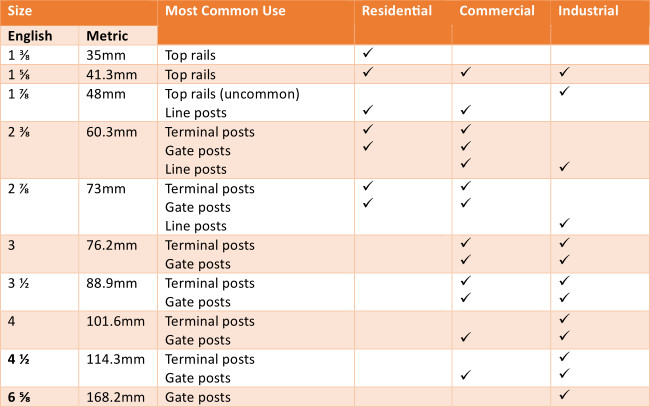
Chain Link Fence Tubing Sizes
If you’re not involved in the fence business, shopping for chain link fence tubing can be quite confusing.
There are so many different sizes, wall thicknesses or gauges, diameters and more to consider. In this article, we’re going to look at the most common chain link fence tubing sizes and where they might be used. We’ll also share a little more information about outside diameter or OD, nominal bore or NB, and other things you need to know.
What Are Chain Link Fence Tubing Sizes?
Most chain link fences are built using a structure made from round tubing. This applies whether you’re using a North American specification with top rails and tension bars or you plan to build a diamond mesh fence with diagonal stays, straining wires and no top rails.
Sometimes, chain link fence systems are designed with angle iron posts and round tension rods, but that’s very much the exception to the rule!
So in most cases, chain link fence tubing sizes refer to the diameter of the round tubing that will be used for your fence.
What Are the Most Common Chain Link Fence Tubing Sizes?
The simplest way to make sense of common chain link fence tubing sizes is to look at it in a chart, so here’s a table that will help you to find the right tubing size for your project.

How to Convert from English to Metric and Vice Versa
Sometimes, you’re given a dimension or diameter for your fence structure that’s in a measurement system you don’t usually use. Fortunately, it’s easy to convert from inches to millimetres and vice versa.
Convert from Inches to Millimeters
To convert from inches to millimetres, multiply the inch dimension in decimals (not fractions) by 25.4. This will give you the dimension in millimetres.
Convert from Millimeters to Inches
To convert from millimetres to inches, divide the number in millimetres by 25.4. This will give you the dimension in inches in decimals.
nominal bore Versus outside diameter
The next important thing you need to know about chain link fence tubing sizes is that there are two methods of measuring the diameter of tubing and pipe: outside diameter or OD and nominal bore or NB.
outside diameter, as the name suggests, is the diameter of the pipe or tubing measured from outside edge to opposite outside edge. nominal bore, however, is the diameter measured from inside edge to opposite inside edge. So it’s smaller than outside diameter.
It’s important to note that some types of pipe, like Schedule 40, might be described using the nominal bore dimension. This means that a 3-inch NB pipe would actually be 3 ½ inches OD.
Always ensure that you’re using the right system for measuring your pipe!
wall thickness or Gauge
The next important thing you need to know about chain link fence tubing sizes is the wall thickness or gauge of the tubing or pipe.
Residential fence projects usually use thinner, lighter-weight tubing, while commercial and industrial projects will usually use not only larger diameter tubing and pipe but also pipe and tubing with thicker walls or gauges.
This will increase the strength of the fence, but it will also increase the cost. So if you get two quotes that appear to be for the same thing but are very different, be sure to ask about wall thickness or gauge!
Chain Link Fence Tubing Sizes Also Dictate Fitting Sizes
The last thing we want to mention when we’re talking about chain link fence tubing sizes is that the sizes of the structural members you use will dictate the size of most of the fittings you need.
So larger top rails, line posts and terminal and gate posts also mean larger rail ends, larger brace bands, tension bands and post caps. So choose your tubing sizes first, and then shop for hardware to make sure it all works together!


